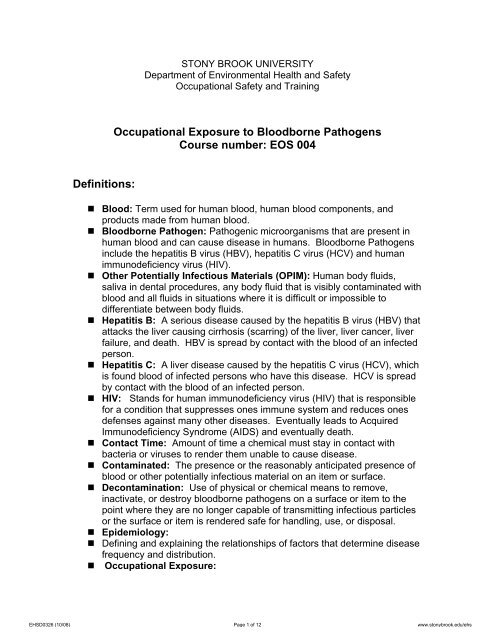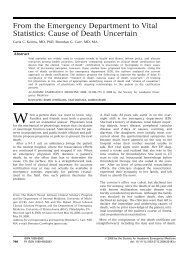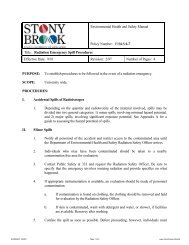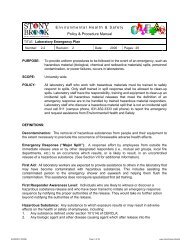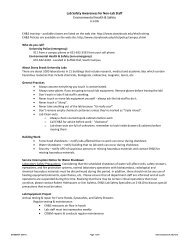Occupational Exposure to Bloodborne Pathogens - Stony Brook ...
Occupational Exposure to Bloodborne Pathogens - Stony Brook ...
Occupational Exposure to Bloodborne Pathogens - Stony Brook ...
Create successful ePaper yourself
Turn your PDF publications into a flip-book with our unique Google optimized e-Paper software.
STONY BROOK UNIVERSITY<br />
Department of Environmental Health and Safety<br />
<strong>Occupational</strong> Safety and Training<br />
<strong>Occupational</strong> <strong>Exposure</strong> <strong>to</strong> <strong>Bloodborne</strong> <strong>Pathogens</strong><br />
Course number: EOS 004<br />
Definitions:<br />
• Blood: Term used for human blood, human blood components, and<br />
products made from human blood.<br />
• <strong>Bloodborne</strong> Pathogen: Pathogenic microorganisms that are present in<br />
human blood and can cause disease in humans. <strong>Bloodborne</strong> <strong>Pathogens</strong><br />
include the hepatitis B virus (HBV), hepatitis C virus (HCV) and human<br />
immunodeficiency virus (HIV).<br />
• Other Potentially Infectious Materials (OPIM): Human body fluids,<br />
saliva in dental procedures, any body fluid that is visibly contaminated with<br />
blood and all fluids in situations where it is difficult or impossible <strong>to</strong><br />
differentiate between body fluids.<br />
• Hepatitis B: A serious disease caused by the hepatitis B virus (HBV) that<br />
attacks the liver causing cirrhosis (scarring) of the liver, liver cancer, liver<br />
failure, and death. HBV is spread by contact with the blood of an infected<br />
person.<br />
• Hepatitis C: A liver disease caused by the hepatitis C virus (HCV), which<br />
is found blood of infected persons who have this disease. HCV is spread<br />
by contact with the blood of an infected person.<br />
• HIV: Stands for human immunodeficiency virus (HIV) that is responsible<br />
for a condition that suppresses ones immune system and reduces ones<br />
defenses against many other diseases. Eventually leads <strong>to</strong> Acquired<br />
Immunodeficiency Syndrome (AIDS) and eventually death.<br />
• Contact Time: Amount of time a chemical must stay in contact with<br />
bacteria or viruses <strong>to</strong> render them unable <strong>to</strong> cause disease.<br />
• Contaminated: The presence or the reasonably anticipated presence of<br />
blood or other potentially infectious material on an item or surface.<br />
• Decontamination: Use of physical or chemical means <strong>to</strong> remove,<br />
inactivate, or destroy bloodborne pathogens on a surface or item <strong>to</strong> the<br />
point where they are no longer capable of transmitting infectious particles<br />
or the surface or item is rendered safe for handling, use, or disposal.<br />
• Epidemiology:<br />
• Defining and explaining the relationships of fac<strong>to</strong>rs that determine disease<br />
frequency and distribution.<br />
• <strong>Occupational</strong> <strong>Exposure</strong>:<br />
EHSD0326 (10/08) Page 1 of 12 www.s<strong>to</strong>nybrook.edu/ehs
• A reasonably anticipated skin, eye, mucous membrane, or parenteral<br />
contact with blood or other potentially infectious materials (OPIM) that may<br />
result from the performance of an employee’s duties.<br />
• <strong>Exposure</strong> Incident:<br />
• A specific eye, mouth, other mucous membrane, non-intact skin or<br />
parenteral contact with blood or other OPIM that results from the<br />
performance of an employee’s duties.<br />
OSHA Policy<br />
• <strong>Exposure</strong> control plan<br />
• Information and training<br />
• Recordkeeping requirements<br />
• Engineering controls, work practices, and personal protective equipment<br />
(PPE)<br />
• Sharps injury log<br />
University’s <strong>Exposure</strong> Control Plan<br />
• <strong>Exposure</strong> determination (job classifications)<br />
• Implementation schedule (time of hire, annually)<br />
• Compliance methods<br />
• Work area restrictions<br />
• Universal precautions<br />
• Personal protective equipment<br />
• Needleless systems<br />
• Sharps with Engineered Sharps Injury Protections (SESIP)<br />
• Housekeeping<br />
• Regulated medical waste disposal<br />
• Laundry procedures<br />
• Hepatitis B Vaccine Program<br />
• Post exposure and follow up<br />
• Solicitation of non-management employees<br />
• Training<br />
Modes of Transmission<br />
• <strong>Bloodborne</strong> pathogens can be transmitted when infectious blood or OPIM<br />
is introduced in<strong>to</strong> the bloodstream of a person.<br />
• Transmission of bloodborne pathogens in the workplace can occur<br />
through the following routes of transmission:<br />
◦ Mucous Membrane<br />
◦ Parenteral<br />
• Mucous membrane exposure means that the infected blood or OPIM<br />
enters your body through contact with a mucous membrane found in your<br />
eyes, nose or mouth.<br />
EHSD0326 (10/08) Page 2 of 12 www.s<strong>to</strong>nybrook.edu/ehs
• Parenteral exposure: means that the infected blood or OPIM is<br />
introduced directly in<strong>to</strong> your body through a break in the skin. Examples<br />
include:<br />
◦ a needle-stick injury or<br />
◦ a cut with a piece of contaminated glass<br />
◦ Human bites<br />
Hepatitis B (serum hepatitis)<br />
• "Hepatitis B" is also available in Portable Document Format (PDF, 26KB,<br />
2pg.)<br />
• Versión en español<br />
• More information on hepatitis<br />
What is hepatitis B?<br />
Hepatitis B is a liver disease caused by the<br />
hepatitis B virus (HBV). The virus can cause<br />
lifelong infection, cirrhosis (scarring) of the liver,<br />
liver cancer, liver failure and death.<br />
Who gets hepatitis B?<br />
One out of 20 people in the United States will get<br />
infected with HBV some time during their lives.<br />
Anyone can get hepatitis B, but you are at<br />
greater risk if you:<br />
• have sex with someone infected with HBV<br />
• have multiple sex partners<br />
• are a man and have sex with men<br />
• have ever been diagnosed with a sexually transmitted disease<br />
• are an injection drug user<br />
• live in the same house with someone who has lifelong (chronic) HBV<br />
infection<br />
• are a health care or public safety worker who has contact with human<br />
blood<br />
• are an infant born <strong>to</strong> an HBV-infected mother<br />
• are a hemodialysis patient<br />
• are an infant/child or immigrant from areas with high rates of infection<br />
EHSD0326 (10/08) Page 3 of 12 www.s<strong>to</strong>nybrook.edu/ehs
How is the virus spread?<br />
Hepatitis B virus can be found in the blood and, <strong>to</strong> a lesser extent, saliva, semen<br />
and other body fluids of an infected person. It is spread by direct contact with<br />
infected body fluids; usually by needle stick injury or sexual contact. Hepatitis B<br />
virus is not spread by casual contact.<br />
What are the symp<strong>to</strong>ms of hepatitis B?<br />
The symp<strong>to</strong>ms of hepatitis B include fatigue, poor appetite, s<strong>to</strong>mach pain, fever,<br />
nausea, vomiting and occasionally joint pain, hives or rash. Urine may become<br />
darker in color, and then jaundice (a yellowing of the skin and whites of the eyes)<br />
may appear. Adults are more likely than children <strong>to</strong> develop symp<strong>to</strong>ms; however,<br />
up <strong>to</strong> 50 percent of adults who have acute infection do not have any symp<strong>to</strong>ms.<br />
How soon do symp<strong>to</strong>ms appear?<br />
The symp<strong>to</strong>ms may appear six weeks <strong>to</strong> six months after exposure, but usually<br />
within four months.<br />
For how long is a person able <strong>to</strong> spread the virus?<br />
The virus can be found in blood and other body fluids several weeks before<br />
symp<strong>to</strong>ms appear and generally persists for several months afterward.<br />
Approximately 10 percent of infected adults may become long-term (chronic)<br />
carriers of the virus. Infants infected at birth have a 90 percent chance of<br />
becoming chronically infected.<br />
What is the treatment for hepatitis B?<br />
There are no special medicines or antibiotics that can be used <strong>to</strong> treat a person<br />
that is acutely infected once the symp<strong>to</strong>ms appear. Generally, bed rest is all that<br />
is needed. Interferon is the most effective treatment for chronic HBV infection<br />
and is successful in 25 <strong>to</strong> 50 percent of cases. Chronic carriers of HBV should<br />
avoid drinking alcohol or taking medications which are harmful <strong>to</strong> the liver, as<br />
these actions can make the liver disease worse.<br />
What precautions should hepatitis B carriers take?<br />
Chronic hepatitis B carriers should follow standard hygienic practices <strong>to</strong> ensure<br />
that close contacts are not directly contaminated by his or her blood or other<br />
body fluids. Carriers must not share razors, <strong>to</strong>othbrushes or any other object that<br />
may become contaminated with blood. In addition, susceptible household<br />
members, particularly sexual partners, should be immunized with hepatitis B<br />
vaccine. It is important for carriers <strong>to</strong> inform their dentist and health care<br />
providers.<br />
EHSD0326 (10/08) Page 4 of 12 www.s<strong>to</strong>nybrook.edu/ehs
How can hepatitis B be prevented?<br />
A safe and effective vaccine <strong>to</strong> prevent hepatitis B is available. The hepatitis B<br />
vaccine is recommended for people in high-risk settings who have not already<br />
been infected and for infants who are born <strong>to</strong> infected mothers. It is<br />
recommended that all children and adolescents be vaccinated against hepatitis B<br />
along with their routine childhood immunizations beginning at birth. A special<br />
hepatitis B immune globulin is also available for people who are exposed <strong>to</strong> the<br />
virus. In the event of exposure <strong>to</strong> hepatitis B, consult a doc<strong>to</strong>r or the local health<br />
department.<br />
Hepatitis B Vaccine is offered <strong>to</strong> employees who are in job classifications<br />
which are at risk <strong>to</strong> exposure <strong>to</strong> HBV at no cost <strong>to</strong> the employee.<br />
Hepatitis C<br />
• "Hepatitis C" is also available in Portable Document Format (PDF, 36 KB,<br />
3pg.)<br />
• Versión en español<br />
• More information on hepatitis<br />
What is hepatitis C?<br />
Hepatitis C is a liver disease caused by the<br />
hepatitis C virus (HCV), which is found in the blood<br />
of persons who have this disease. HCV is spread<br />
by contact with the blood of an infected person.<br />
Who gets hepatitis C?<br />
Persons at highest risk for HCV infection include:<br />
• persons who ever injected illegal drugs,<br />
including those who injected once or a few times many years ago,<br />
• people who had blood transfusions, blood products or organ donations<br />
before June 1992, when sensitive tests for HCV were introduced for blood<br />
screening, and<br />
• persons who received clotting fac<strong>to</strong>rs made before 1987.<br />
Other persons at risk for hepatitis C include:<br />
• long-term kidney dialysis patients,<br />
• health care workers after exposures (i.e., needle stick or splashes <strong>to</strong> the<br />
eye) <strong>to</strong> the blood of an infected person while on the job,<br />
• infants born <strong>to</strong> HCV-infected mothers,<br />
EHSD0326 (10/08) Page 5 of 12 www.s<strong>to</strong>nybrook.edu/ehs
• people with high-risk sexual behavior, multiple partners and sexually<br />
transmitted diseases,<br />
• people who snort cocaine using shared equipment, and<br />
• people who have shared <strong>to</strong>othbrushes, razors and other personal items<br />
with a family member who is HCV-infected.<br />
How is the virus spread?<br />
Like hepatitis B virus, hepatitis C virus is spread when blood of an infected<br />
person enters the body of a person who is not infected, such as through sharing<br />
needles or "works" when shooting drugs or occupational needle stick injury. The<br />
risk of sexual transmission has not been thoroughly studied but appears <strong>to</strong> be<br />
low in long-term, monogamous relationships. There is no evidence that the<br />
hepatitis C virus can be transmitted by casual contact such as hugging or<br />
shaking hands, through foods, by sharing eating utensils or drinking glasses, or<br />
by coughing or sneezing. Hepatitis C is not spread by breastmilk.<br />
What are the symp<strong>to</strong>ms and consequences of infection?<br />
Approximately 20 percent of persons exposed <strong>to</strong> the virus develop symp<strong>to</strong>ms<br />
which may include jaundice (yellowing of the skin and whites of the eyes),<br />
fatigue, dark-colored urine, s<strong>to</strong>mach pain, loss of appetite and nausea. After the<br />
initial infection, 15-25 percent will recover and 75-85 percent will become<br />
chronically infected (life-long infection). Approximately 70 percent of persons<br />
chronically infected may develop liver disease, sometimes decades after initial<br />
infection.<br />
How soon do symp<strong>to</strong>ms occur?<br />
Symp<strong>to</strong>ms may occur from two weeks <strong>to</strong> six months after exposure but usually<br />
within six <strong>to</strong> nine weeks.<br />
When and for how long is a person able <strong>to</strong> spread hepatitis C?<br />
Persons with acute hepatitis C virus infection are generally contagious from one<br />
or more weeks before the onset of symp<strong>to</strong>ms. The contagious period is indefinite<br />
in chronically infected persons. All persons who test positive should be<br />
considered <strong>to</strong> be potentially contagious.<br />
What is the treatment for hepatitis C?<br />
Drugs (anti-viral) are licensed for treatment of persons with chronic hepatitis C.<br />
Combination drug therapy, using pegylated interferon and ribavirin, can get rid of<br />
the virus in up <strong>to</strong> five out of ten of persons with genotype 1, the most common<br />
EHSD0326 (10/08) Page 6 of 12 www.s<strong>to</strong>nybrook.edu/ehs
genotype in the U.S. and eight out of ten persons with genotype 2 or 3. It is<br />
important <strong>to</strong> know that not everyone will need treatment. The decision <strong>to</strong> treat<br />
hepatitis C is complex and is best made by a physician experienced in treating<br />
the disease.<br />
Is donated blood tested for this virus?<br />
Since the early 1990s, blood donation centers throughout the U.S. have routinely<br />
used a blood donor screening test for hepatitis C. Widespread use of this test<br />
has significantly reduced the number of post-transfusion hepatitis C infections.<br />
How can the risk of chronic liver disease be reduced among persons<br />
infected with hepatitis C?<br />
People who are infected with hepatitis C should not drink alcohol. They should<br />
talk with their doc<strong>to</strong>r before taking any new medications, including over-thecounter<br />
and herbal medications. They should also talk with their doc<strong>to</strong>r about<br />
getting the hepatitis A and hepatitis B vaccines.<br />
How can the spread of hepatitis C be prevented?<br />
People who have had hepatitis C should remain aware that their blood and<br />
possibly other body fluids are potentially infectious.<br />
• Do not shoot drugs; if you shoot drugs, s<strong>to</strong>p and get in<strong>to</strong> a treatment<br />
program; if you can't s<strong>to</strong>p, never share needles, syringes, water or<br />
"works", and get vaccinated against hepatitis A and B.<br />
• Do not share personal care items that might have blood on them (razors,<br />
<strong>to</strong>othbrushes).<br />
• If you are a health care or public safety worker, always follow routine<br />
barrier precautions and safely handle needles and other sharps; get<br />
vaccinated against hepatitis B.<br />
• Consider the risks if you are thinking about getting a tat<strong>to</strong>o or body<br />
piercing. You might get infected if the <strong>to</strong>ols have someone else's blood on<br />
them or if the artist or piercer does not follow good health practices.<br />
• HCV can be spread by sex, but this is rare. If you are having sex with<br />
more than one steady sex partner, use latex condoms correctly and every<br />
time <strong>to</strong> prevent the spread of sexually transmitted diseases. You should<br />
also get vaccinated against hepatitis B.<br />
• If you are infected with HCV, do not donate blood, organs or tissue.<br />
Is there a vaccine for hepatitis C?<br />
At present time, a hepatitis C vaccine is not available.<br />
EHSD0326 (10/08) Page 7 of 12 www.s<strong>to</strong>nybrook.edu/ehs
HIV/AIDS<br />
HIV<br />
Human Immunodeficiency Virus (HIV) is a virus. You may hear that someone is<br />
"HIV infected", "has HIV infection", or "has HIV disease." These are all terms that<br />
mean the person has HIV in his or her body and<br />
can pass the virus <strong>to</strong> other people.<br />
HIV attacks the body's immune system. The<br />
immune system protects the body from<br />
infections and disease, but has no clear way <strong>to</strong><br />
protect it from HIV. Over time, most people<br />
infected with HIV become less able <strong>to</strong> fight off<br />
the germs that we are all exposed <strong>to</strong> every day.<br />
Many of these germs do not usually make a<br />
healthy person sick, but they can cause lifethreatening<br />
infections and cancers in a person<br />
whose immune system has been weakened by<br />
HIV.<br />
People infected with HIV may have no symp<strong>to</strong>ms for 10 or more years. They may<br />
not know they are infected. An HIV test is the only way <strong>to</strong> find out if you have<br />
HIV. See HIV Counseling and Testing for information and resources on HIV<br />
testing in New York State.<br />
HIV spreads when infected blood, semen, vaginal fluids, or breast milk gets in<strong>to</strong><br />
the bloodstream of another person through:<br />
• direct entry in<strong>to</strong> a blood vessel;<br />
• mucous linings, such as the vagina, rectum, penis, mouth, eyes, or nose,<br />
or<br />
• a break in the skin.<br />
HIV is not spread through saliva (spit).<br />
HIV is spread through:<br />
• Vaginal, anal, or oral sex without using a condom.<br />
• Sharing needles, syringes, or works <strong>to</strong> inject drugs, vitamins, hormones,<br />
steroids, or medicines.<br />
• Women with HIV infection can pass HIV <strong>to</strong> their babies during pregnancy,<br />
delivery, and breastfeeding.<br />
EHSD0326 (10/08) Page 8 of 12 www.s<strong>to</strong>nybrook.edu/ehs
• People who are exposed <strong>to</strong> blood and/or body fluids at work, like health<br />
care workers, may be exposed <strong>to</strong> HIV through needle-sticks or other onthe-job<br />
exposures.<br />
It may also be possible <strong>to</strong> pass HIV through sharing needles for piercing or<br />
tat<strong>to</strong>oing.<br />
A person infected with HIV can pass the virus <strong>to</strong> others during these activities.<br />
This is true even if the person:<br />
• has no symp<strong>to</strong>ms of HIV<br />
• has not been diagnosed with AIDS<br />
• is taking HIV medications<br />
• has an "undetectable" viral load<br />
HIV is not spread by casual contact like sneezing, coughing, eating or drinking<br />
from common utensils, shaking hands, hugging, or use of restrooms and drinking<br />
fountains.<br />
AIDS<br />
Acquired Immune Deficiency Syndrome (AIDS) is a late stage of HIV disease. There are<br />
medications that have helped people living with HIV or AIDS live longer, healthier lives.<br />
Some people have lived for more than 20 years and have taken medicines for more than<br />
10 years. But, there is no cure.<br />
HIV Treatment:<br />
Drugs FDA Approved for HIV Infection<br />
(U.S. Department of Health & Human Services)<br />
EHSD0326 (10/08) Page 9 of 12 www.s<strong>to</strong>nybrook.edu/ehs
Sharps with Engineered Sharps Injury Protections (SESIP): Safety needles<br />
must be used whenever collection of bodily fluids or delivery of medication is<br />
being performed.<br />
Disposal of Contaminated Waste<br />
• Place sharps in<strong>to</strong> sharp containers<br />
• Place blood soaked bandages and dressings in red bags<br />
• Do not reuse disposable gloves<br />
• Handle soiled linens as little as possible and place in specified laundry<br />
bags<br />
• Decontaminate equipment<br />
Housekeeping<br />
• Plan for cleaning and decontaminating work area<br />
◦ After completing procedures<br />
◦ At the end of the shift<br />
• Physical plant maintains clean, sanitary conditions<br />
• EH&S may get involved in clean up when called in on HAZ MAT spill<br />
Signs and Labels<br />
• Affix biohazard warning labels on…<br />
EHSD0326 (10/08) Page 10 of 12 www.s<strong>to</strong>nybrook.edu/ehs
◦ Regulated waste containers<br />
◦ Refrigera<strong>to</strong>rs/freezers<br />
◦ Shipping containers<br />
• Use red bags for regulated waste<br />
• Label or use sharp containers<br />
<strong>Exposure</strong> Incidents<br />
• Unprotected contact with blood or other potentially infectious materials<br />
during job duties<br />
• Notify your supervisor immediately<br />
• Immediately seek medical treatment<br />
◦ Center for <strong>Occupational</strong> and Environmental Medicine<br />
S<strong>to</strong>ny <strong>Brook</strong> Medical Park<br />
(8:30 a.m. <strong>to</strong> 4:30 p.m.)<br />
◦ Hospital Emergency Room (after hours)<br />
Post <strong>Exposure</strong> Evaluation<br />
• Confidential evaluation by head of <strong>Occupational</strong> Medicine Division<br />
◦ Route of exposure<br />
◦ Source evaluation by permission (Confidentiality Law in NY State)<br />
◦ Review of source evaluation with exposed employee<br />
◦ Counseling on precautions <strong>to</strong> take during period after exposure<br />
◦ Written opinion placed in confidential health record<br />
◦ Heath care professionals are instructed <strong>to</strong> limit their opinions <strong>to</strong>:<br />
◦ Whether Hepatitis B vaccine is indicated and if employee received<br />
the vaccine<br />
◦ Employee has been informed of the results<br />
◦ Employee has been <strong>to</strong>ld about medical conditions as the result of<br />
an exposure<br />
General Prevention Tips<br />
• Follow Universal Precautions<br />
• Carry protective gloves<br />
• Keep cuts and wounds covered with clean bandages<br />
• Avoid needlesticks and other sharp objects<br />
• Avoid <strong>to</strong>uching nose, mouth, eyes when working with blood or other body<br />
fluids<br />
• Clean up any blood or body fluids thoroughly and promptly<br />
• Wash hands thoroughly with soap and water for at least 15 seconds after<br />
removing gloves and whenever you leave area<br />
Universal Precautions<br />
Concept that all blood or other potentially infectious materials must be treated as<br />
though they are known <strong>to</strong> be infectious.<br />
• Engineering controls - remove or isolate worker from hazard<br />
EHSD0326 (10/08) Page 11 of 12 www.s<strong>to</strong>nybrook.edu/ehs
• Work practices - procedures <strong>to</strong> follow<br />
• Personal protective equipment - prevent entry in<strong>to</strong> the body through skin<br />
lesions, membranes of the eye, nose, or mouth<br />
General Prevention Tips<br />
• Avoid <strong>to</strong>uching nose, mouth, eyes when working with blood or other body<br />
fluids<br />
• Clean up any blood or body fluids thoroughly and promptly<br />
• Wash hands thoroughly with soap and water for at least 15 seconds after<br />
removing gloves and whenever you leave area<br />
Solicitation of Non-management Employees<br />
Input from non-managerial employees responsible for direct patient care who are<br />
potentially exposed <strong>to</strong> injuries from contaminated sharps in the identification ,<br />
evaluation, and selection of engineering and work practice controls and shall<br />
document the solicitation in the <strong>Exposure</strong> Control Plan.<br />
EHSD0326 (10/08) Page 12 of 12 www.s<strong>to</strong>nybrook.edu/ehs


